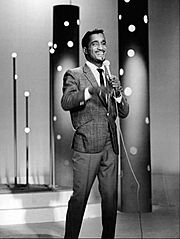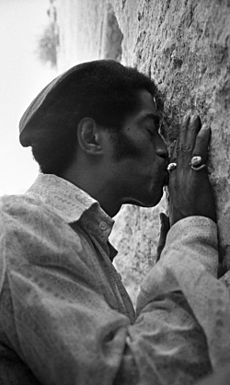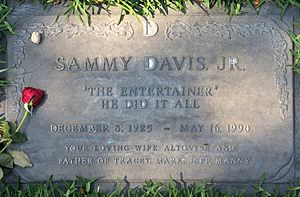Sammy Davis Jr. facts for kids
Quick facts for kids
Sammy Davis Jr.
|
|
|---|---|
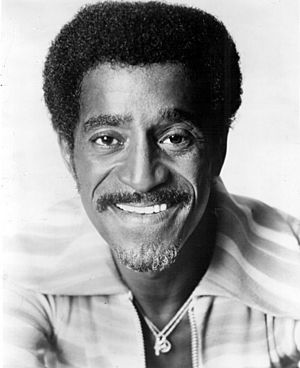
Davis in 1972
|
|
| Born |
Samuel George Davis Jr.
December 8, 1925 New York City, U.S.
|
| Died | May 16, 1990 (aged 64) |
| Resting place | Forest Lawn Memorial Park, Glendale, California, U.S. |
| Occupation |
|
| Years active | 1928–1990 |
| Spouse(s) |
|
| Children | 4 |
| Parent(s) | |
| Musical career | |
| Genres |
|
| Instruments |
|
| Labels | |
| Associated acts | |
Samuel George Davis Jr. (December 8, 1925 – May 16, 1990) was an amazing American entertainer. He was a singer, dancer, actor, comedian, film producer, and television director.
Sammy Davis Jr. started his career at just three years old. He performed in vaudeville shows with his father, Sammy Davis Sr., and the Will Mastin Trio. His first movie role was in 1933. After serving in the military, he rejoined the trio. He became very famous after a show at Ciro's nightclub in 1951.
In 1954, at age 29, Sammy lost his left eye in a car accident. Years later, he became Jewish. He felt a connection between the struggles of African-American people and Jewish people.
Sammy starred on Broadway in Mr. Wonderful (1956). In 1960, he was in the movie Ocean's 11 with the Rat Pack. He was nominated for a Tony Award for his role in the musical Golden Boy (1964). This show featured the first interracial kiss on Broadway. In 1966, he had his own TV show, The Sammy Davis Jr. Show.
His biggest song hit, "The Candy Man", reached number one in 1972. He became a huge star in Las Vegas, earning the nickname "Mister Show Business". Sammy's fame helped break down racial barriers in entertainment. He was honored with the Kennedy Center Honors in 1987 and a Grammy Lifetime Achievement Award in 2001.
Contents
Sammy Davis Jr.'s Early Life
Sammy Davis Jr. was born on December 8, 1925, in Harlem, New York City. His father, Sammy Davis Sr., was an African-American entertainer. His mother, Elvera Sanchez, was a tap dancer. She was born in New York City to Cuban parents.
Sammy's parents were vaudeville dancers. His grandmother raised him when he was a baby. When he was three, his parents separated. His father took him on tour so he wouldn't lose custody.
Learning to Dance and Perform
Sammy learned to dance from his father and his godfather, Will Mastin. He joined their act as a child. They became known as the Will Mastin Trio. Sammy always included the trio in his show titles throughout his career.
Mastin and his father tried to protect Sammy from racism. But when Sammy joined the United States Army in World War II, he faced prejudice. He later said, "Overnight the world looked different. It wasn't one color any more."
At age seven, Sammy played the main character in the film Rufus Jones for President. He sang and danced with Ethel Waters in the movie.
Serving in the Military
In 1944, Sammy was drafted into the U.S. Army when he was 18. He was assigned to the Army's Special Services branch. This group put on shows for the troops. Sammy was discharged in 1945. He later shared, "My talent was the weapon, the power, the way for me to fight."
Sammy Davis Jr.'s Amazing Career
After leaving the army, Sammy rejoined his family's dance act. They performed in clubs. He also recorded blues songs in 1949.
On March 23, 1951, the Will Mastin Trio performed at Ciro's. They were supposed to play for only 20 minutes. But the audience loved Sammy's impressions so much that they performed for almost an hour! Sammy started to become famous on his own.
In 1953, Sammy was offered his own TV show on ABC. It was called Three for the Road—with the Will Mastin Trio. The show aimed to show African Americans as musicians. However, the network could not find a sponsor, so the show was canceled.
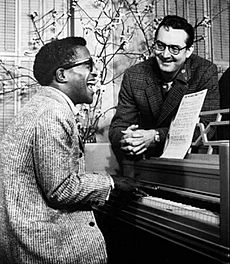
In 1954, Sammy sang the main song for the movie Six Bridges to Cross. In 1956, he starred in the Broadway musical Mr. Wonderful. Even though critics didn't love it, the show was a success.
In 1958, Sammy crowned the winner of the Miss Cavalcade of Jazz beauty contest. This was at the famous fourteenth Cavalcade of Jazz concert.
Joining the Rat Pack
In 1959, Sammy became a member of the Rat Pack. This famous group was led by his friend Frank Sinatra. Other members included Dean Martin, Joey Bishop, and Peter Lawford. They made several movies together, like Ocean's 11 (1960) and Sergeants 3 (1962). They also performed together in Las Vegas.

In 1964, Sammy was the first African American to sing at the Copacabana nightclub in New York.
Sammy was a top performer in Las Vegas. But because of unfair Jim Crow laws, black performers had to stay in separate housing. They couldn't stay in the hotels where they performed. They also couldn't gamble or eat in the hotel restaurants. Sammy later refused to work at places that practiced racial segregation.
Canada offered more opportunities for black performers. In 1959, Sammy starred in his own TV special, Sammy's Parade, on the Canadian network CBC. This was a big step for him.
In 1964, Sammy was very busy. He starred in Golden Boy at night. During the day, he filmed his own talk show in New York. He also recorded songs and performed at charity events. Sammy felt he was working too much, but he loved to perform.
By the late 1960s, his music career slowed down. But he had a big hit with "I've Gotta Be Me" in 1969. He then signed with Motown Records to try new music styles. In 1972, he had an unexpected number one hit with "The Candy Man". This song helped restart his career.
Sammy appeared on many TV shows. He showed off his gunspinning skills on The Rifleman. He also appeared in sitcoms like I Dream of Jeannie and All in the Family. In a famous episode of All in the Family, Sammy kissed Archie Bunker on the cheek.
On December 11, 1967, Sammy and Nancy Sinatra shared a kiss on TV. This was one of the first black-white kisses on US television.
Sammy was friends with Elvis Presley in the late 1960s. They were both top performers in Las Vegas. Sammy even appeared in Elvis's 1970 concert film Elvis: That's the Way It Is.
In 1985, Sammy announced his support for the Sammy Davis Jr. National Liver Institute. In 1988, he planned a tour with Frank Sinatra and Dean Martin. When Martin left, Liza Minnelli joined the tour, called The Ultimate Event. During this tour in 1989, Sammy was diagnosed with throat cancer.
Sammy Davis Jr.'s Personal Life
Car Accident and Faith Journey
Sammy was in a serious car accident on November 19, 1954. He was driving from Las Vegas to Los Angeles. He lost his left eye in the accident. His friend, actor Jeff Chandler, even offered to give one of his own eyes to help Sammy. Sammy wore an eye patch for several months. Later, he got a glass eye, which he wore for the rest of his life.
While in the hospital, Sammy learned about the similarities between Jewish and African-American cultures. Sammy, who was born to a Catholic mother and Baptist father, began studying Jewish history. He converted to Judaism in 1961. He was especially inspired by how the Jewish people had endured many challenges. This accident changed Sammy's career, making him a national celebrity.
Marriages and Family
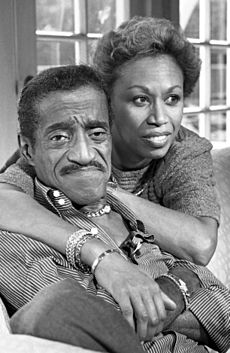
In 1957, Sammy was dating actress Kim Novak. Because Novak was white, some people worried about their relationship. Sammy was even threatened. To protect himself, Sammy briefly married dancer Loray White in 1958. This marriage was quickly dissolved.
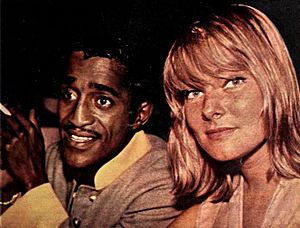
In 1960, Sammy married white, Swedish-born actress May Britt. This caused controversy because interracial marriage was still not widely accepted in the U.S. At the time, laws against mixed-race marriages still existed in many states. Sammy received hate mail while starring in Golden Boy because his character was with a white woman, just like his own life. It wasn't until 1967 that these laws were ruled unconstitutional.
Sammy and May Britt had a daughter named Tracey. They also adopted two sons, Mark and Jeff. Because Sammy worked so much, he spent little time with his family. They divorced in 1968.
In 1968, Sammy started dating Altovise Gore, a dancer. They married on May 11, 1970. They adopted a son named Manny in 1989. Sammy and Altovise were married until his death in 1990.
Hobbies and Interests
Sammy was a passionate photographer. He loved taking pictures of his family and friends. His photos included rare shots of his father dancing and close friends like Jerry Lewis and Frank Sinatra. He also photographed political figures like Robert Kennedy and Martin Luther King Jr.
Sammy also enjoyed shooting and owning guns. He was very skilled at fast-draw competitions and gunspinning. He even showed off his gunspinning skills on TV shows.
Sammy Davis Jr.'s Political Views
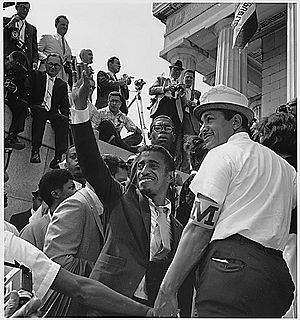
Sammy Davis Jr. was a registered Democrat. He supported John F. Kennedy's 1960 election campaign. He also supported Robert F. Kennedy's 1968 campaign.
Later, he became good friends with President Richard Nixon, who was a Republican. Sammy publicly supported Nixon in 1972. He even went on a USO tour to South Vietnam at Nixon's request.
In 1973, Nixon invited Sammy and his wife, Altovise, to stay overnight at the White House. This was the first time African Americans were invited to do so. They stayed in the Lincoln Bedroom. Sammy later said he regretted supporting Nixon, feeling that Nixon didn't keep his promises on civil rights. Sammy was a longtime supporter of Reverend Jesse Jackson's organization, Operation PUSH.
Illness and Passing
In August 1989, Sammy started feeling symptoms of cancer. Doctors found a tumor in his throat. Sammy was a heavy smoker. He chose not to have surgery to remove part of his throat because he wanted to keep his voice. He received radiation therapy instead. His voice box was later removed when the cancer returned. He was released from the hospital on March 13, 1990.
Sammy Davis Jr. passed away from throat cancer on May 16, 1990, at his home in Beverly Hills, California. He was 64 years old. He was buried at Forest Lawn Memorial Park in Glendale, California. Two days after his death, the neon lights of the Las Vegas Strip were turned off for ten minutes to honor him.
Sammy left most of his money to his wife, Altovise. However, he owed a large amount of money to the IRS. Altovise had to sell some of his belongings to pay the debt. Friends like Quincy Jones and Jerry Lewis helped with a fundraising concert.
Sammy Davis Jr.'s Legacy
Sammy Davis Jr. left a lasting impact on entertainment and civil rights.
Portrayals in Media
- In an episode of Charlie's Angels, Sammy played himself and an impersonator.
- Comedian Jim Carrey has played Sammy Davis Jr. on stage and in movies.
- On Saturday Night Live, Sammy has been portrayed by Eddie Murphy and Billy Crystal.
- Don Cheadle played Sammy in the 1998 HBO film The Rat Pack, winning a Golden Globe Award.
- In 2017, Sammy's family worked with Lionel Richie to make a movie about his life.
Honors and Awards
Before his death, ABC aired Sammy Davis, Jr. 60th Anniversary Celebration. Many stars, including Frank Sinatra and Michael Jackson, paid tribute to him. The show won an Emmy Award.
Grammy Awards
| Year | Category | Song | Result |
|---|---|---|---|
| 2002 | Grammy Hall of Fame Award | "What Kind of Fool Am I?" | Inducted |
| 2001 | Grammy Lifetime Achievement Award | Winner | |
| 1972 | Pop Male Vocalist | "Candy Man" | Nominee |
| 1962 | Record of the Year | "What Kind of Fool Am I?" | Nominee |
| 1962 | Male Solo Vocal Performance | "What Kind of Fool Am I?" | Nominee |
Emmy Awards
| Year | Category | Program | Result |
|---|---|---|---|
| 1990 | Outstanding Variety, Music or Comedy | Sammy Davis Jr.'s 60th Anniversary Celebration | Winner |
| 1989 | Outstanding Guest Actor in a Comedy Series | The Cosby Show | Nominee |
| 1980 | Outstanding Cameo Appearance in a Daytime Drama Series | One Life to Live | Nominee |
| 1966 | Outstanding Variety Special | The Swinging World of Sammy Davis Jr. | Nominee |
| 1956 | Best Specialty Act — Single or Group | Sammy Davis Jr. | Nominee |
Other Recognitions
| Year | Category | Organization | Program | Result |
|---|---|---|---|---|
| 2017 | Singer | National Rhythm & Blues Hall of Fame | Inducted | |
| 2008 | International Civil Rights Walk of Fame | Martin Luther King Jr. National Historic Site | Inducted | |
| 2006 | Las Vegas Walk of Stars | front of Riviera Hotel | Inducted | |
| 1989 | NAACP Image Award | NAACP | Winner | |
| 1987 | Kennedy Center Honors | John F. Kennedy Center for the Performing Arts |
Honoree | |
| 1977 | Best TV Actor — Musical/Comedy | Golden Globe | Sammy and Company (1975) | Nominee |
| 1974 | Special Citation Award | National Academy of Television Arts and Sciences | Winner | |
| 1968 | NAACP Spingarn Medal Award | NAACP | Winner | |
| 1965 | Best Actor — Musical | Tony Award | Golden Boy | Nominee |
| 1961 | Man of the Year | American Guild of Variety Artists | Winner | |
| 1960 | Recording | Hollywood Walk of Fame | Inducted |
Sammy Davis Jr. on Screen and Stage
Film Appearances
- Rufus Jones for President (1933) – Rufus Jones
- Anna Lucasta (1958) – Danny Johnson
- Porgy and Bess (1959) – Sportin' Life
- Ocean's 11 (1960) – Josh Howard
- Pepe (1960) – Sammy Davis Jr.
- Sergeants 3 (1962) – Jonah Williams
- Robin and the 7 Hoods (1964) – Will
- A Man Called Adam (1966) – Adam Johnson
- Salt and Pepper (1968) – Charles Salt
- Sweet Charity (1969) – Big Daddy
- One More Time (1970) – Charles Salt
- Elvis: That's the Way It Is (1970) – Himself
- The Cannonball Run (1981) – Morris Fenderbaum
- Cannonball Run II (1984) – Morris Fenderbaum
- Alice in Wonderland (1985) – The Caterpillar / Father William
- Tap (1989) – Little Mo
Stage Performances
- Mr. Wonderful (1957), musical
- Golden Boy (1964), musical – Tony Nomination for Best Actor in a Musical
- Stop the World – I Want to Get Off (1978) musical revival
Television Shows
- What's My Line? (1955)
- General Electric Theater (1960)
- The Rifleman (1962) – 2 episodes
- Ben Casey (1963)
- The Sammy Davis Jr. Show – Host (1966)
- Alice In Wonderland or What's a Nice Kid Like You Doing in a Place Like This? (1966)
- The Wild Wild West (1966)
- Batman (1966)
- I Dream of Jeannie (1967)
- Rowan & Martin's Laugh-In (1968–1973)
- The Mod Squad (1969–1970)
- The Beverly Hillbillies (1969)
- Here's Lucy (1970)
- All in the Family (1972)
- Chico and the Man (1975)
- Sammy & Company – host/performer (1975–1977)
- Charlie's Angels (1977)
- Archie Bunker's Place (1980)
- General Hospital (1982, 1983)
- The Jeffersons (1984)
- Fantasy Island (1984)
- Gimme a Break! (1985)
- The Cosby Show (1989)
- Sammy Davis, Jr. 60th Anniversary Celebration (1990)
See also
 In Spanish: Sammy Davis Jr. para niños
In Spanish: Sammy Davis Jr. para niños
- History of the Jews in the African diaspora
- List of Hispanic and Latino Americans


